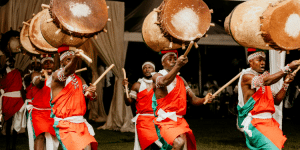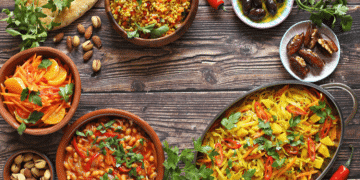Exploring South African Cuisine: Your Essential Guide to Local Flavors and Traditions
Introduction to South African Cuisine
Overview of South Africa’s Multicultural Culinary Landscape
South Africa’s cuisine is a vibrant tapestry woven from a multitude of cultural influences.
This multicultural nation offers a rich palette of flavors that reflect the diverse ethnic backgrounds of its people.
From traditional African dishes to Indian curries and Dutch desserts, South African cuisine is a melting pot of tastes and ingredients.
Each region and community brings its own unique touch, creating a culinary landscape that is as colorful as it is delicious.
The Historical Influences Shaping South African Food Culture
South African food culture is deeply rooted in its history.
The indigenous people of South Africa, including the Khoisan and Bantu-speaking tribes, laid the foundation with their traditional foods such as mealie pap (maize porridge) and game meats.
The arrival of the Dutch East India Company in the 1600s brought European influences, particularly noticeable in dishes like bobotie, a curried meat dish with a custard topping.
The Cape Malay community, descendants of Southeast Asian slaves, added fragrant spices and flavorful curries to the mix.
In addition, the British colonial period introduced puddings and roasts, while the arrival of Indian indentured laborers in the 19th century infused the cuisine with aromatic spices and rice dishes, exemplified by the beloved Durban curry and bunny chow.
These historical layers have created a culinary heritage that is both diverse and uniquely South African.

The Significance of Food in Understanding the Rainbow Nation
Food in South Africa is more than just sustenance; it is a lens through which one can understand the nation’s rich cultural tapestry, often referred to as the Rainbow Nation.
Culinary practices and traditions are celebrated as a way to connect with heritage and community.
Sharing a meal at a braai (barbecue) or enjoying a Cape Malay curry is a communal and inclusive experience that transcends cultural boundaries.
The act of preparing and enjoying food together plays a crucial role in the social fabric, fostering unity and mutual understanding among South Africa’s diverse communities.
Whether it’s at local markets featuring an array of international foods or at traditional gatherings in townships, South African cuisine acts as a bridge, bringing people together and celebrating their shared identity.
As we move deeper into this culinary journey, we’ll discover how these diverse influences and practices continue to shape the vibrant food scene in South Africa today.
The Art of Braai: South Africa’s Beloved Barbecue Tradition
The braai (pronounced “bry”) is more than just a method of cooking in South Africa; it’s a cultural and social phenomenon that brings individuals and communities together.
This beloved tradition is deeply entwined with South African identity and celebrates the nation’s rich culinary and cultural heritage.
Cultural Significance and Social Aspects
The braai is a communal event, embodying the spirit of togetherness and unity.
It transcends social and economic boundaries, making it a universal celebration in South Africa.
Whether it’s a casual weekend gathering, a public holiday, or a significant life event, the braai is an integral part of the social fabric.
Friends and family gather around the grill, exchanging stories, sharing laughter, and enjoying good food and company.
The process itself is relaxed and unhurried, often extending over several hours, making it as much about the experience as it is about the meal.
Essential Braai Elements
A traditional South African braai is characterized by specific key elements that define the experience:
- ✅Boerewors: This coiled, spiced beef sausage is a staple at any braai. Its name, derived from the Afrikaans words for “farmer’s sausage,” speaks to its rustic and hearty nature.
- ✅Steaks: Thick, juicy cuts of beef are seared over the grill, often marinated to enhance flavor. Each region and household may have its preferred cut and marinade, adding to the rich diversity of braai culture.
- ✅Braaibroodjie: The iconic grilled sandwich composed of cheese, tomato, and onion, with slices of bread toasted to perfection over the coals, bringing a satisfying crunch and meltingly delicious filling.
The Importance of Cooking with Wood or Charcoal
At the heart of a traditional braai is the method of cooking—using wood or charcoal.
This method imparts a distinctive, smoky flavor to the food that is impossible to replicate with gas grills.
There’s a ceremonial aspect to starting the fire, waiting for the coals to reach the perfect temperature, and then carefully managing the heat.
This hands-on approach not only enhances the flavors but also connects participants more deeply with the cooking process.
Gas may offer convenience, but it lacks the soul and spirit that wood and charcoal bring to a true South African braai.
As we explore further into South Africa’s culinary diversity, this rich tradition of the braai showcases how food brings people together, weaving stories, history, and warmth into every bite.
Cape Malay Cuisine: A Fusion of Flavors
Historical Origins and Southeast Asian Influences
Cape Malay cuisine is a captivating blend of flavors that speaks volumes about South Africa’s rich history.
This unique culinary tradition originated with the arrival of Southeast Asian slaves and political exiles, who were brought to the Cape of Good Hope by the Dutch East India Company.
These individuals, primarily from Indonesia, Malaysia, and other parts of Southeast Asia, melded their native cooking techniques with the ingredients available in South Africa.
This fusion of Southeast Asian spices and Dutch culinary influences laid the foundation for what we now celebrate as Cape Malay cuisine.
Signature Dishes
Mild Curries
Cape Malay curries are iconic for their mild and aromatic profiles. Unlike the fiery curries commonly associated with Indian cuisine, Cape Malay curries emphasize subtlety.
Ingredients like cinnamon, cardamom, and cloves are used alongside meats and vegetables, creating rich, fragrant dishes often served with saffron rice.
A quintessential Cape Malay curry would not be complete without a touch of sweetness, usually from the inclusion of dried fruit or a sprinkle of sugar.
Sambal
Sambal is another signature component of Cape Malay cuisine.
This spicy, relish-like condiment typically combines tomatoes, onions, and chilies with a hint of vinegar and sugar, offering a balanced heat that complements many traditional dishes.
It often accompanies curries and grilled meats, adding a flavorful kick to the meal.
Traditional Desserts
Cape Malay desserts are a delightful blend of textures and flavors.
The koe’sister, a doughnut-like treat sprinkled with coconut, is a perfect example.
Unlike the syrupy koeksister, the koe’sister is less sweet and more spiced, making it a unique end to a spicy meal.
These desserts highlight the blending of European techniques with Southeast Asian ingredients, creating sweets that are both familiar and exotic.
Characteristics of Cape Malay Cooking Style
The Cape Malay cooking style is characterized by its use of fragrant spices, slow cooking methods, and the integration of sweet and savory elements.
Common spices include turmeric, ginger, and cumin, which are often combined into homemade spice mixes.
Slow cooking allows the flavors to fully develop, resulting in dishes that are rich and deeply layered. Another hallmark is the balance of sweet and savory components, often achieved by adding dried fruits or a touch of sugar to savory dishes.
As we transition to the next exploration of South Africa’s edible treasures, it’s clear that Cape Malay cuisine offers a vibrant tapestry of history and culture through its unique flavors and techniques.
Traditional African Staples and Street Food
Mealie Pap and Its Versatile Role in South African Dining
Mealie pap, a maize porridge, is a cornerstone of South African cuisine, enjoyed by various ethnic groups across the country.
This staple food can be served in multiple ways, showcasing its incredible versatility.
For breakfast, mealie pap can be paired with milk and sugar, creating a nutritious start to the day.
At lunchtime or dinner, it often accompanies meat dishes like boerewors or grilled chops, absorbing the rich, saucy flavors alongside it.
In some regions, it is used as a base for stews such as the traditional potjie, a slow-cooked stew filled with vegetables and meat.
For a simple yet satisfying meal, many people enjoy it with a dollop of tomato and onion gravy or a spicy relish known as chakalaka.
The adaptability of mealie pap makes it an essential element of every South African kitchen.
Popular Dishes Across Different Ethnic Groups
South Africa’s diverse ethnic landscape results in a mosaic of culinary delights.
Each community contributes its unique flavors and dishes to the country’s food scene:
- ✅Samp and Beans: A combination of dried corn kernels and beans, commonly eaten by the Xhosa people.
- ✅Morogo: Wild African spinach enjoyed by many rural communities, often served with a side of mealie pap.
- ✅Bunny Chow: A mouthwatering dish from the Indian community in Durban, consisting of a hollowed-out loaf of bread filled with spicy curry.
- ✅Bobotie: A Cape Malay dish featuring spiced minced meat topped with an egg-based custard.
These dishes highlight the rich variety present in South Africa’s food culture.
The Significance of Township Cuisine and Local Markets
Township cuisine, celebrated for its authenticity and robust flavors, plays a significant role in South African food culture.
Local markets and street food stalls are vibrant hubs where people from all backgrounds gather to share a meal, making them essential to the social fabric.
Markets offer a diverse range of dishes, from grilled meats to fresh seafood and exotic treats. Vendors showcase local favorites such as:
- ✅Braaibroodjie: A South African grilled cheese sandwich, often enjoyed at a braai.
- ✅Biltong: Air-dried, cured meat snacks, perfect for munching on the go.
- ✅Samoosas: Spicy, filled pastries originating from the Indian community.
These markets are not just about food; they are lively settings where music, dance, and community spirit converge.
Exploring these culinary hotspots is a fantastic way to immerse oneself in the local culture and savor the true essence of South Africa.
As we continue our journey into the richly varied flavors of South African cuisine, the next stop offers a taste of the country’s wine culture, deeply intertwined with its history and landscape.
South African Wine Culture
The Historical Journey of South African Winemaking
South Africa’s wine history unfolds like a fine-aged vintage, dating back to the 1650s when the Dutch East India Company established a supply station at the Cape of Good Hope.
This initiative included planting vineyards to produce wine for the sailors’ long voyages.
Over centuries, this modest beginning blossomed into a vibrant wine industry, setting the stage for today’s diverse offerings.
Key Wine Regions: Cape Winelands, Stellenbosch, and Franschhoek
South Africa’s premier wine regions, particularly the Cape Winelands, Stellenbosch, and Franschhoek, are renowned globally.
Situated amidst breathtaking landscapes, these areas provide ideal terroirs for a variety of grape cultivars.
Cape Winelands
The Cape Winelands region, wrapping around the Western Cape, is fertile ground for numerous vineyards.
This beautiful area prides itself on a unique blend of old-world charm and modern innovation, offering rich red wines and crisp whites.
Stellenbosch
Stellenbosch, often considered the heart of South African wine country, is famed for its robust reds, particularly Cabernet Sauvignon and Merlot.
The town’s heritage, combined with its forward-thinking viticulture, makes it a significant player in the wine scene.
Franschhoek
Franschhoek, meaning “French Corner,” reflects its roots with Huguenot settlers who brought winemaking expertise from France.
This picturesque region is synonymous with elegant, handcrafted wines, often produced using traditional methods.
Wine Tasting Experiences and Local Varieties
Visiting South Africa’s wine country isn’t just about savoring exceptional wines but also about the immersive experience.
Wineries in these regions offer diverse tasting experiences ranging from intimate, cellar tastings to elaborate food and wine pairings in verdant vineyards.
Chenin Blanc and Pinotage
Two standout grape varieties that encapsulate South African wine excellence are Chenin Blanc and Pinotage.
Chenin Blanc, a versatile white, ranges from fresh and fruity to rich and full-bodied. Pinotage, a uniquely South African grape, is a cross between Pinot Noir and Cinsault, known for its smoky, earthy profile with robust berry flavors.
Engaging with South African wine culture offers insight into the nation’s complex heritage and innovative spirit.
As we journey further into South Africa’s culinary landscape, prepare to explore how other influences and contemporary innovations blend seamlessly with tradition.
Spicy Influences and Modern Interpretations
Peri-Peri Sauce: A Fiery Favorite
South African cuisine features an impressive array of flavors, and few are as bold and beloved as peri-peri sauce.
This fiery condiment hails from Mozambique but has become deeply ingrained in South African food culture.
Known for its use of African Bird’s Eye Chili, peri-peri sauce combines crushed chiles with lemon, garlic, black pepper, and sometimes additional spices like paprika and oregano.
This vibrant and zesty mix makes the sauce a versatile marinade for chicken and a popular condiment in many dishes.
Whether you’re at a casual eatery or a fine dining restaurant, you’re likely to find peri-peri sauce enhancing the menu.
Durban’s Indian Influence: The Bunny Chow Phenomenon
Durban, South Africa, boasts the largest Indian population outside of India, bringing with it a rich culinary heritage that has seamlessly blended into South African cuisine. One iconic dish that symbolizes this fusion is bunny chow.
This unique meal consists of a hollowed-out loaf of bread filled with a spicy curry, usually lamb, chicken, or vegetarian.
Bunny chow is more than just a dish; it’s a cultural emblem and a beloved comfort food that offers a taste of Durban’s vibrant Indian community.
It’s a flavorful experience that melds the textures of soft bread with the aromatic and hearty curry inside.
Evolving Contemporary Cuisine
While traditional dishes play a significant role, contemporary South African cuisine continually evolves.
Chefs across the country are innovating, blending indigenous ingredients with modern techniques and international influences.
This includes incorporating local flavors like rooibos, tamarind, and wild herbs into sophisticated dishes.
Markets and restaurants are also embracing global trends, from vegan and vegetarian options to artisanal ice creams featuring unique South African tastes.
The culinary scene is a tapestry of the new and old, reflecting the dynamic nature of the Rainbow Nation’s evolving identity.
Understanding these spicy influences and contemporary interpretations enriches the appreciation of South Africa’s culinary landscape.
This journey through flavor continues, leading us to explore even more delightful gastronomic adventures.
| Dessert/Feature | Description |
|---|---|
| 🍰 Melktert (Milk Tart) | A creamy custard-like filling made with milk, sugar, flour, and eggs, baked in a flaky pastry crust and topped with cinnamon. A staple in many South African homes. |
| 🍮 Malva Pudding | A sticky, sweet sponge cake soaked in a buttery, caramelized sauce, often served with custard or ice cream. Infused with apricot jam for a rich texture. |
| 🍩 Koeksisters | Twisted, syrup-soaked doughnuts with a crispy exterior and juicy, soft interior. A beloved sweet treat enjoyed by all ages in South Africa. |
| 🍦 Unique Ice Cream Flavors | Innovative ice cream flavors made with local ingredients like tamarind, roasted sorghum biscuits, coconut, and rooibos, offering a unique twist on a classic treat. |
| 🌿 Rooibos-Infused Treats | Rooibos, a local herb, adds a unique fragrant note to cakes, biscuits, and ice cream, creating a distinctly South African flavor. |
| 🍰 Innovative Bakeries and Confectioneries | Cities like Cape Town and Johannesburg have trendy spots offering modern twists on traditional sweets, with contemporary presentations that appeal to both the taste buds and the eyes. |
Dining Options for All Preferences
South Africa’s culinary scene caters to all kinds of preferences, from fine dining establishments in bustling cities to quaint local markets offering diverse street foods.
Whether you’re a foodie craving gourmet experiences or a vegetarian seeking plant-based options, the Rainbow Nation’s dining landscape has something to delight every palate.
Fine Dining Scene in Major Cities
Cape Town, Franschhoek, and Johannesburg play host to some of South Africa’s most acclaimed fine dining restaurants.
These establishments blend the country’s rich multicultural influences with contemporary culinary techniques to create unforgettable dining experiences.
Cape Town is home to culinary gems like The Test Kitchen and La Colombe, which are renowned for their innovative dishes and impeccable service.
In Franschhoek, often dubbed the food and wine capital of the country, you can enjoy exquisite meals at Le Quartier Français and Foliage.
In Johannesburg, restaurants like Marble and DW Eleven-13 offer gourmet delights that highlight South Africa’s fresh, local ingredients.
Each of these cities provides a range of elegant dining options that promise to satisfy even the most discerning food enthusiasts.
Vegetarian and Vegan Options in South African Cuisine
Despite being a meat-loving society, South Africa has embraced the growing global trend of vegetarian and vegan dining.
Major cities often have dedicated vegetarian restaurants and cafes offering a variety of plant-based dishes.
Cafes and Indian restaurants are great bets for finding flavorful vegetarian meals.
Restaurants like The Conscious Kitchen in Cape Town and Free Food in Johannesburg are celebrated for their creative and satisfying vegan menus.
Supermarkets also stock a range of soy products and seasonal produce, making it easier for vegan diners to navigate the local food scene.
Local Markets and Food Halls as Culinary Destinations
Local markets are one of South Africa’s not-so-secret gems, offering a colorful and immersive culinary experience.
These markets are bustling hubs where you can sample a diverse array of local produce and street food, reflecting the country’s rich cultural tapestry.
Neighbourgoods Market in Cape Town and Johannesburg is a must-visit.
Here, you can savor everything from traditional South African fare to international delights, all while enjoying the vibrant, communal atmosphere.
Food hall-style venues are perfect spots to sample unique treats like biltong, braaibroodjie, and peri-peri chicken.
Near the coast, markets also offer freshly caught seafood like lobster and prawns, often served fried or grilled.
For dessert lovers, stalls showcasing gelato, decadent donuts, and other confections ensure a sweet end to your culinary adventure.
Each of these dining avenues – fine dining restaurants, vegetarian-friendly cafes, and lively local markets – provides a window into the rich, diverse, and ever-evolving food culture of South Africa.
Beyond the gourmet and the casual, the allure of South African cuisine lies in its ability to consistently innovate while staying true to its multicultural roots.





